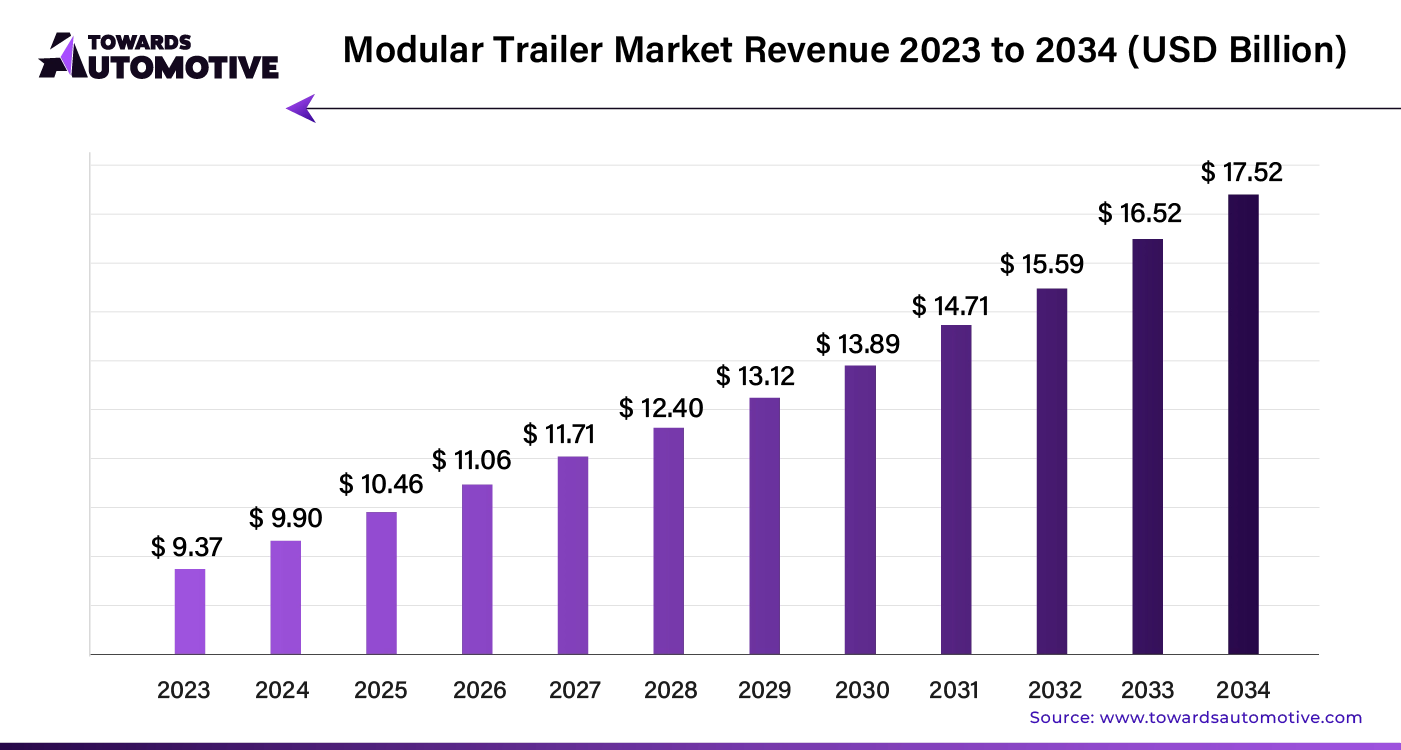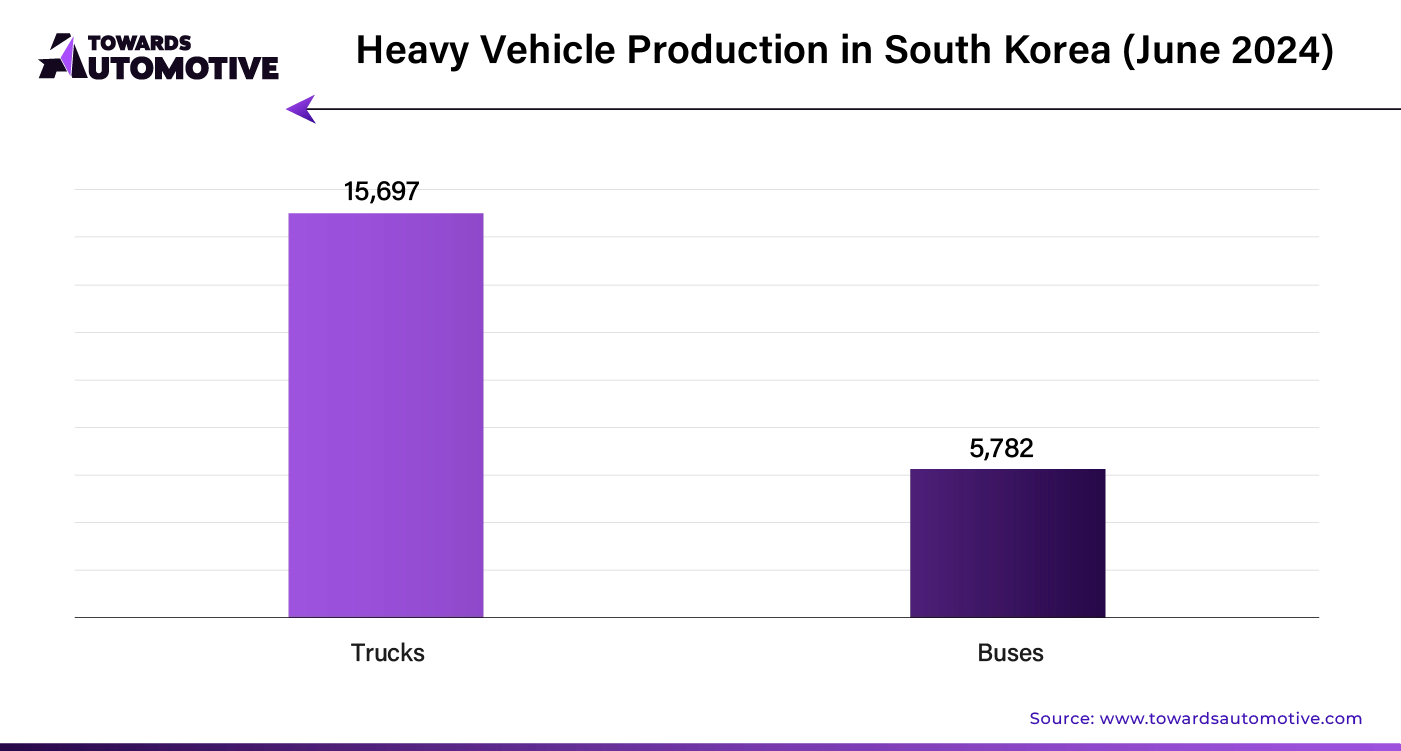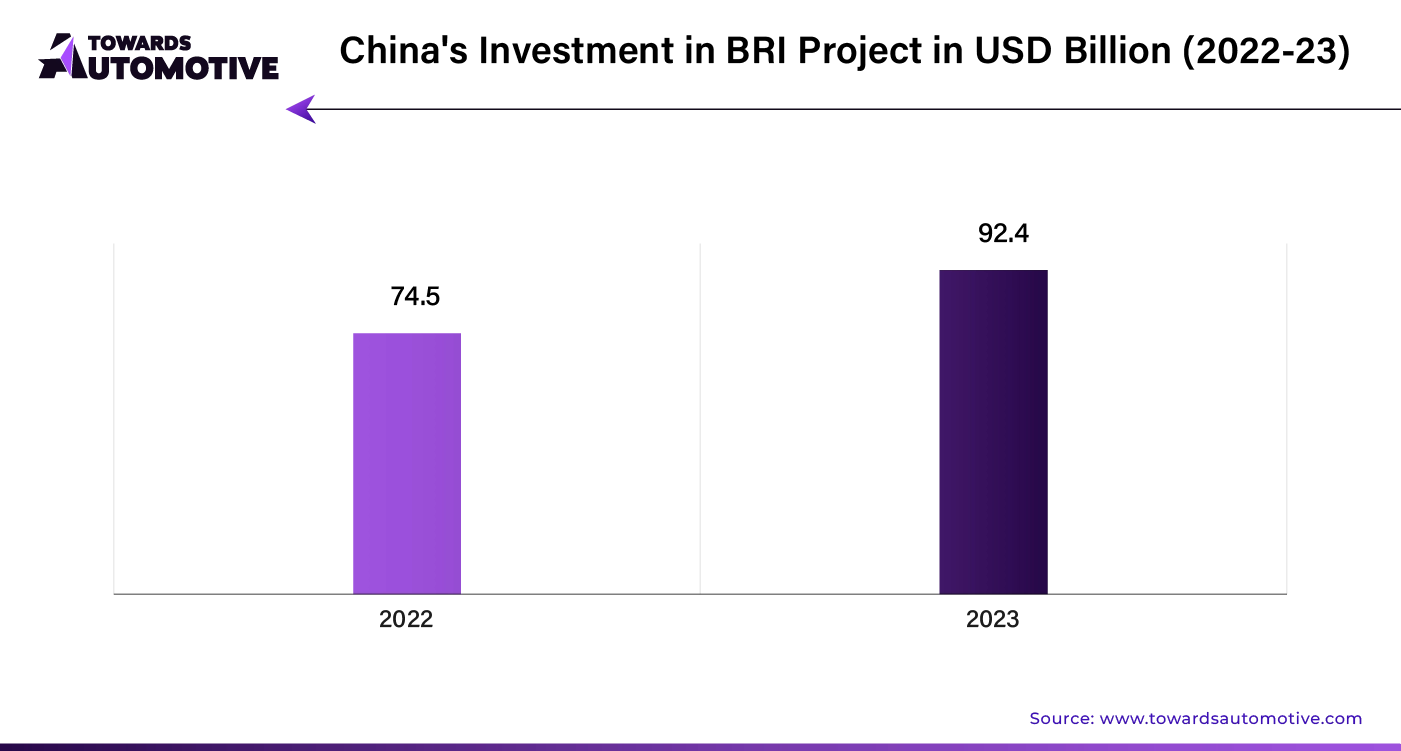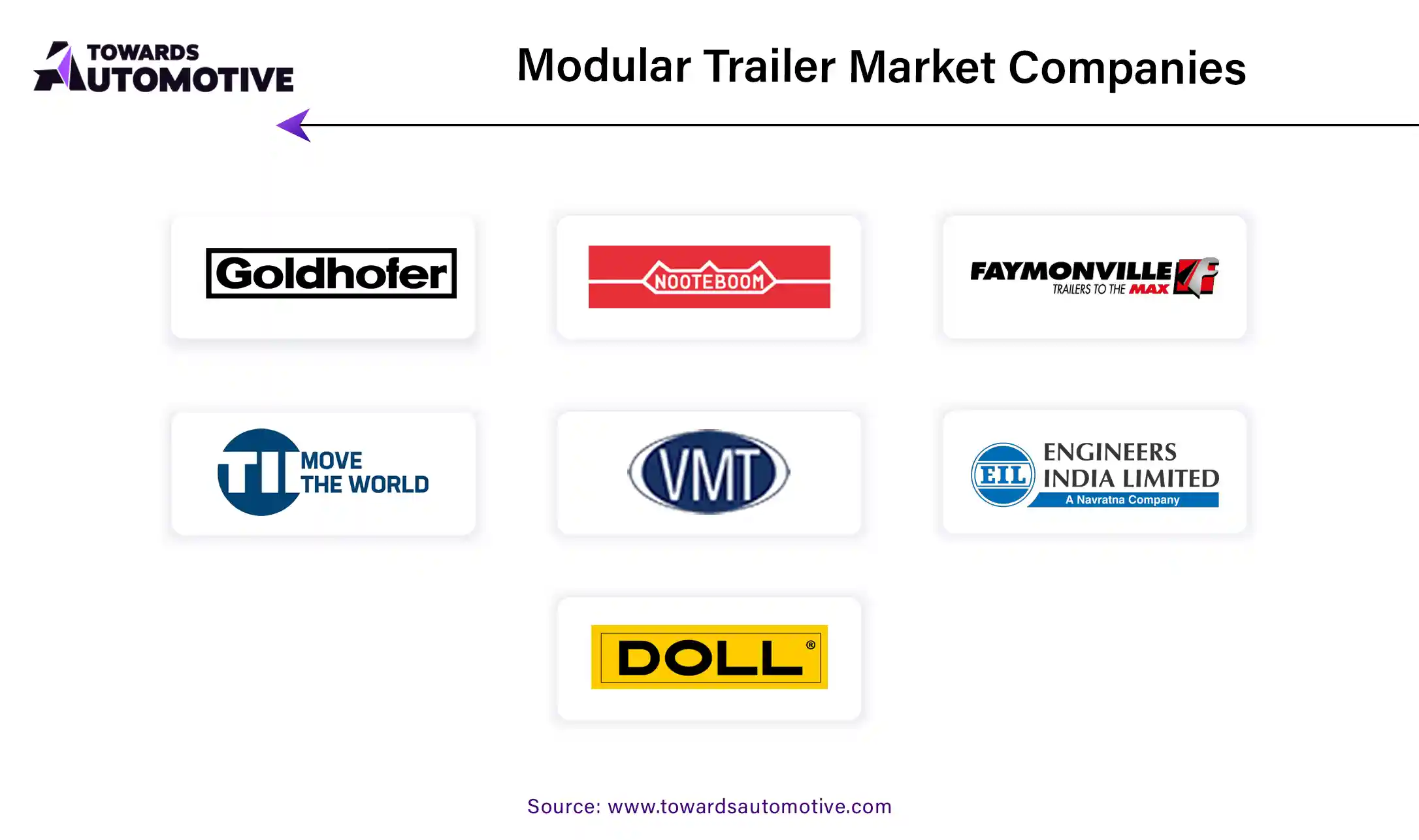April 2025
The modular trailer market is projected to reach USD 17.52 billion by 2034, expanding from USD 10.46 billion in 2025, at an annual growth rate of 5.7% during the forecast period from 2025 to 2034.

Unlock Infinite Advantages: Subscribe to Annual Membership
The modular trailer industry is undergoing a significant transformation, driven by three key trends that are reshaping its landscape.
First, there is a growing adoption of telematics and digital technologies, which is enhancing both the efficiency and safety of trailers. These advanced systems allow for real-time monitoring of trailer operations, optimizing routes, reducing fuel consumption, and improving overall fleet management. The integration of digital technology also enables predictive maintenance, minimizing downtime and ensuring that trailers are always operating at peak performance.
Secondly, the global shift towards renewable energy projects is fueling the demand for modular trailers, particularly for the transportation of large and heavy components such as wind turbine blades, solar panels, and other infrastructure necessary for green energy installations. As the renewable energy sector continues to expand, the need for specialized trailers that can safely and efficiently transport these oversized components is on the rise.
Lastly, the ongoing wave of urbanization and the surge in infrastructure projects across the globe are significantly boosting the demand for modular trailers within the construction and logistics sectors. With more cities expanding and new infrastructure being developed, there is an increasing need for trailers that can transport construction materials, machinery, and other heavy equipment to urban and remote job sites. The automotive market valued at USD 4,070.19 billion in 2023, is experiencing growth and is projected to surpass USD 6,678.28 billion by 2032, with a significant CAGR of over 5.66%.
These trends underscore a dynamic period of growth and innovation in the modular trailer industry, with companies adapting to meet the evolving needs of the market. As telematics and digital technology become more integrated, and as renewable energy and urbanization continue to drive demand, the future of modular trailers looks both promising and pivotal to global development.
The modular trailer market is poised for significant growth, driven by several key factors.
Firstly, ongoing investments in infrastructure projects are fueling the demand for modular trailers, which are essential for transporting construction materials, heavy machinery, and specialized equipment. As governments and private entities continue to invest in building and upgrading roads, bridges, and other infrastructure, the need for reliable and adaptable transportation solutions is increasing.
Secondly, the expansion of renewable energy projects, particularly in the wind and solar sectors, is creating new opportunities for the modular trailer industry. The shift towards renewable energy sources has necessitated the transportation of large and complex components, such as wind turbine blades, towers, and sizable solar panels. Modular trailers, known for their ability to handle oversized and heavy loads, are becoming increasingly crucial in supporting the logistics of these projects.
Moreover, the rapid growth of e-commerce has led to a surge in demand for faster and more efficient delivery of goods. As consumers increasingly expect quick shipping times, companies are seeking versatile transportation solutions that can adapt to various logistical challenges. Modular trailers offer the flexibility and efficiency needed to meet these demands, making them a preferred choice in the evolving landscape of goods transportation.
The modular trailer market faces several significant challenges, particularly in the heavy-duty transportation sector. One of the primary issues is the need to adhere to a complex web of regulations. These trailers must comply with stringent rules governing dimensions, weight limits, axle configurations, and safety standards. Failure to meet these requirements can result in penalties, operational delays, and increased costs, making regulatory compliance a critical concern for manufacturers and operators.
Another major challenge is the inadequacy of infrastructure in certain regions. Limited accessibility to specific routes due to poor infrastructure can significantly hinder the efficient transport of heavy loads. This limitation not only increases transportation costs but also complicates logistical planning, forcing companies to find alternative, often less efficient, routes to avoid infrastructure-related obstacles.
The high initial costs associated with the design and manufacture of modular trailers present another barrier, particularly for new entrants in the market. Developing these specialized trailers requires substantial investment in technology, materials, and skilled labor. These high costs can deter smaller companies from entering the market, limiting competition and innovation.
Furthermore, as modular trailers become an increasingly popular alternative to traditional construction methods, competition in the market is intensifying. New companies are entering the market, and established players are vying for leadership by enhancing their product offerings and expanding their market presence. This heightened competition is pushing companies to innovate continuously, improve efficiency, and reduce costs, adding pressure on all market participants.
AI integration is set to significantly enhance growth in the modular trailer market by driving innovation and efficiency. Through advanced data analytics, AI can optimize trailer design and manufacturing processes, leading to more customized and efficient products. Predictive maintenance powered by AI will reduce downtime and extend the lifespan of trailers by identifying potential issues before they become critical. Additionally, AI-driven logistics solutions will streamline operations by improving route planning and fleet management, resulting in cost savings and increased operational efficiency.
AI’s ability to analyze market trends and consumer preferences will also allow manufacturers to adapt quickly to changing demands, ensuring that modular trailers meet evolving market needs. Automated production processes will reduce human error and increase production speed, further boosting market growth. In essence, AI will enhance product quality, operational efficiency, and adaptability, positioning the modular trailer market for accelerated growth and innovation.
The supply chain in the modular trailer market operates through a streamlined network of manufacturers, suppliers, distributors, and customers. It begins with raw material procurement, where suppliers provide essential components such as steel, aluminum, and specialized trailer parts. These materials are then transported to manufacturing facilities, where modular trailers are assembled.
Manufacturers focus on quality control and efficiency, ensuring that trailers meet industry standards and customer requirements. After assembly, trailers are distributed through a network of logistics providers who manage transportation to various regions. This stage involves coordinating shipping schedules and handling to minimize delays.
Distributors play a crucial role by delivering trailers to dealers or directly to end customers. They ensure that inventory levels are maintained and that customer demands are met promptly. Throughout this process, real-time tracking systems and inventory management tools are employed to monitor progress and address any potential disruptions.
In summary, the modular trailer supply chain hinges on effective coordination between suppliers, manufacturers, logistics providers, and distributors. By optimizing each link in the chain, the industry can ensure timely delivery and high-quality products to meet market demands.
The Modular Trailer market ecosystem is built on several core components, including chassis, axles, suspension systems, and coupling mechanisms. Each element plays a crucial role in ensuring the versatility and functionality of modular trailers, which are used for transporting oversized and heavy loads across various industries.
Chassis forms the backbone of modular trailers, providing structural support and load distribution. Leading companies like Schmitz Cargobull and Kässbohrer excel in designing robust chassis systems that enhance stability and safety during transportation.
Axles are essential for load-bearing and maneuverability. FAYMONVILLE and Goldhofer are known for their advanced axle systems that offer superior load capacity and flexibility, allowing trailers to handle a diverse range of heavy and oversized cargo.
Suspension Systems contribute to ride comfort and load stability. Companies such as WABCO and BPW Bergische Achsen focus on developing high-performance suspension systems that improve trailer handling and reduce wear and tear on both the trailer and the cargo.
Coupling Mechanisms ensure secure attachment between trailers and prime movers. JOST and SAF-Holland lead in innovating coupling technologies that enhance safety and efficiency in modular trailer operations.
Together, these companies and their specialized components create a dynamic and efficient Modular Trailer market ecosystem, supporting diverse applications across industries.
The global modular trailer market is witnessing significant growth, with several countries leading the charge due to various infrastructural and industrial developments. This article explores the top five markets—South Korea, Japan, the United Kingdom, China, and the United States—highlighting their growth drivers, challenges, and opportunities.
South Korea: Renewable Energy Projects and Industrial Growth Propel Market Expansion
South Korea is a key player in the modular trailer market, with an anticipated Compound Annual Growth Rate (CAGR) of approximately 7.3% from 2024 to 2034. The country’s increasing investments in renewable energy projects, particularly in solar and wind energy, are driving the demand for modular trailers. These trailers are essential for transporting heavy and oversized components like wind turbine parts, solar panels, and other machinery to project sites.
Additionally, South Korea’s expanding international trade networks have heightened the need for cross-border transportation solutions, where modular trailers play a crucial role. The strong presence of modular trailer manufacturers in the country further boosts its market potential, positioning South Korea as a significant opportunity for growth in this sector.

Japan: Urbanization and Infrastructural Projects Drive Market Growth
Japan's modular trailer market is expected to grow at a CAGR of around 6.9% between 2024 and 2034. The country's ongoing infrastructural projects, including road construction, bridge enhancements, and urban development programs, are major drivers of this growth. Modular trailers are vital for transporting heavy equipment, construction materials, and manufactured components necessary for these projects.
Japan’s rapid urbanization and population growth have led to increased demand for public facilities and construction in urban areas. Consequently, modular trailers have become a crucial solution for relocating building materials and equipment, making them integral to Japan’s urban development efforts.
Government initiatives aimed at economic growth and sustainability through infrastructure investment and transportation improvement also contribute to the rising demand for modular trailers in Japan.
The United Kingdom: Technological Advancements Fuel Market Expansion
In the United Kingdom, the modular trailer market is projected to achieve a CAGR of approximately 6.8% from 2024 to 2034. The country’s growing investment in renewable energy projects, such as solar and wind farms, is a significant factor driving market growth. Modular trailers are essential for transporting large components like wind turbine blades, towers, and solar panels to installation sites, thereby boosting demand.
Moreover, technological advancements in trailer design, components, and materials have led to more efficient and secure modular trailers. Innovations in telematics data management, load capacity improvement, and the use of lightweight materials cater to evolving customer needs, further stimulating market growth in the UK.
China: Industrial Expansion Boosts Market Demand
China’s modular trailer market is set to grow at a CAGR of about 6.0% over the next decade. The country’s extensive infrastructure development, including the construction of highways, bridges, railways, and energy infrastructure, has significantly contributed to the demand for modular trailers. These trailers are crucial for transporting capital-intensive equipment across regions, particularly in sectors such as manufacturing, construction, and mining.
As China’s manufacturing industry continues to expand, the need for efficient transportation solutions has increased. Modular trailers, capable of handling heavy and oversized loads, are becoming increasingly important in supporting the country’s industrial growth and infrastructure projects.

The United States: Infrastructural Projects and Trade Drive Market Growth
In the United States, the modular trailer market is anticipated to register a CAGR of approximately 5.8% from 2024 to 2034. The country’s growing industries, including manufacturing, mining, and energy extraction, require the transportation of large and heavy equipment, fueling the demand for modular trailers. These trailers are critical for moving oversized cargo to and from ports, distribution centers, and manufacturing facilities, supporting the growth of international trade.
The United States is a major player in the modular trade market, with significant import and export activities. Modular trailers play a vital role in facilitating the transportation of heavy cargo, which is essential for the country’s economic growth and infrastructure development.
Leading Position of Multi-Axle Modular Trailers
Multi-axle modular trailers are poised to remain the dominant segment in the market, with an anticipated CAGR of 5.1% in 2024. These trailers are preferred for their capacity to evenly distribute the weight of heavy and oversized cargo across multiple axles, which enhances stability and safety during transport. This makes them the ideal choice for moving large machinery, extensive equipment, and substantial spare parts.
The design of multi-axle trailers supports the handling of significant loads by spreading the tensile strength across various axles. This design feature minimizes the risk of accidents such as rollovers, tipping, or jackknifing, thereby ensuring the safety of the cargo, the trailer itself, and other road users. Their reliability and security make multi-axle trailers a preferred option for businesses that require dependable transportation solutions.
Growth in 2-Axle Modular Trailer Sales
On the other hand, the 2-axle segment is expected to experience notable growth, with a projected CAGR of 4.9% by 2034. Two-axle trailers are known for their flexibility and are used for a variety of tasks, from everyday operations to more specialized needs. Their adaptability allows them to handle various sizes and shapes of cargo, making them popular across multiple industries.
One significant advantage of 2-axle trailers is their more affordable initial cost compared to multi-axle models. This cost efficiency makes them an attractive option for a broader range of customers, including small businesses and independent transport operators. The lower financial investment required allows for easier market entry and fleet expansion.
Moreover, 2-axle trailers can be equipped with different container sizes to accommodate specific transportation needs, further enhancing their versatility. Their ability to integrate into various industries and applications highlights their growing popularity among manufacturers and transporters.
The global modular trailer market is shaped by both established leaders and emerging players. In-depth industry statistics reveal that several companies are positioning themselves at the forefront of the market by embracing cutting-edge technologies and innovative practices.
Faymonville stands out as a top global producer specializing in modular trailers designed for specialized transport and super-heavy loads. Known for its extensive range of modular trailers—including self-steering, extendable, and low bed models—Faymonville caters to diverse sectors such as construction, mining, and energy. Their trailers are distinguished by their high-quality engineering and adaptability, making them a preferred choice for handling complex transport needs.
K-Line Trailers Ltd. is another significant player in the market, renowned for its robust trailers and hydraulic transportation equipment. They offer solutions like extendable trailers and custom-designed hauling equipment, tailored for industries involved in civil works, infrastructure development, and heavy equipment transportation. Their focus on durability and customization ensures that their products meet the rigorous demands of various industrial applications.
Both companies are strengthening their market positions through strategic product portfolio development and smart mergers and acquisitions, contributing to their leadership in the modular trailer industry.

By Type
By Axles
By Application
By Region
April 2025
April 2025
March 2025
March 2025
Dr. Arjun Patel is a distinguished expert in the automotive industry, holding advanced degrees in Automotive Engineering and Mechanical Engineering. His expertise spans automotive market dynamics, technological advancements, and sustainable practices. Dr. Patel excels in conducting in depth research and analysis on market trends, consumer preferences, and the economic implications within the automotive sector. He is renowned for his insightful publications on topics such as electric vehicles, autonomous driving technologies, and the evolution of sustainable transportation solutions. Dr. Patels research contributions have significantly advanced understanding in the field, earning him recognition as a leading authority in automotive research and analysis.
We offer automotive expertise for market projections and customizable research, adaptable to diverse strategic approaches.
Contact Us